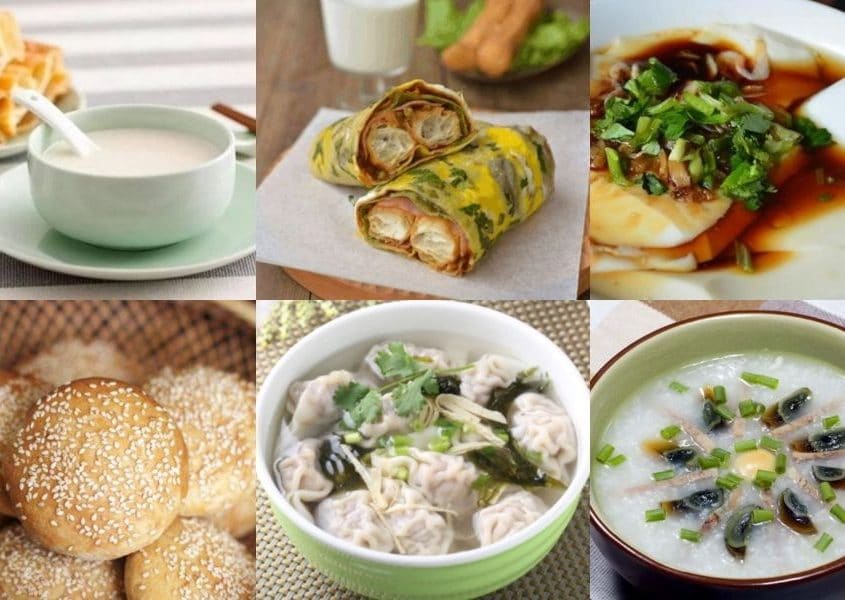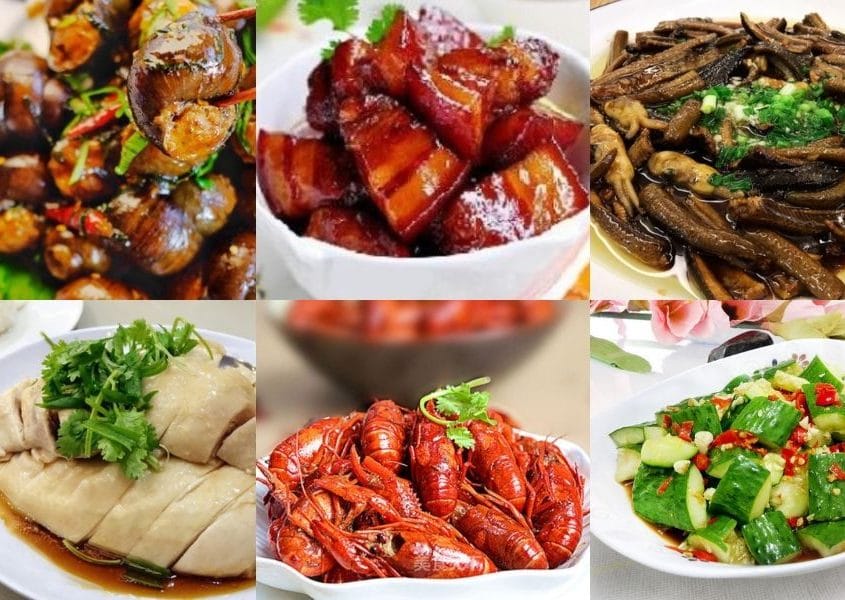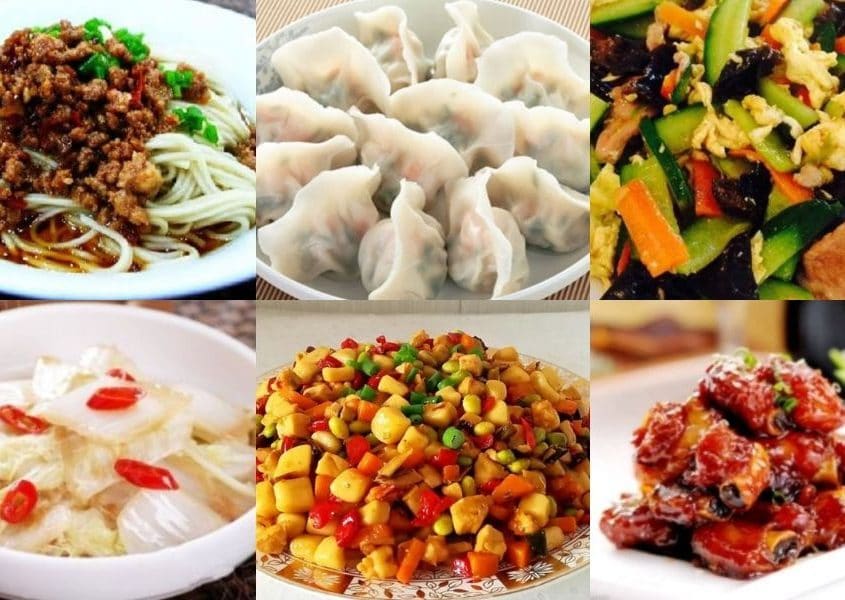Asian Language School
27 August 2019
Local Chinese Food Demystified
Wondering what people in China eat? There are so many varieties of Chinese cuisine. In summary, Chinese food is divided into four main groups: 鲁菜 lǔcài (Shandong cuisine), 川菜 chuāncài (Sichuan cuisine), 粤菜 yuècài (Cantonese cuisine) and 苏菜 sūcài (Jiangsu cuisine). Let’s take a look at some popular local Chinese food.
Breakfast

Bottom: pastry, wonton, congee
豆浆油条 dòujiāng youtiao
Chinese donut eaten with sweet soy milk served in a bowl, a bit like croissant eaten with coffee in France.
煎饼果子 jiānbǐng guǒzi
Translated simply as Chinese crepe and sometimes affectionately called jianbing, it’s basically a Chinese donut or cracker wrap. Watch a video of jianbing being made.
豆腐脑 dòufunǎo
豆腐 means “beancurd” and 脑 means “brain”. This is actually a tofu pudding which can be served salty or sweet. People in the northern China prefer salty food, so the tofu pudding is served with shredded meat and vegetables. People in the southern China prefer sweet food, so the tofu pudding is served with sweet syrup, and can be served hot or cold.
烧饼 shāobǐng
A type of pastry that can be sweet or savoury, mostly eaten in northern China. The sweet pastry typically includes red bean filling, while the savoury one typically includes meat.
馄饨 húntún
Often called wonton in English (derived from Cantonese), it is practically a wrapped meat dumpling cooked by steaming or boiling. The shape of wonton is often thought to resemble ancient gold coins and thus traditionally eaten on the second day of the Chinese New Year to attract abundance for the year.
粥 zhōu
Called congee, it is simply a rice porridge. A plain congee uses only rice and water that are slowly cooked. There are many varieties of congee. A popular type of congee is century egg and pork congee (皮蛋瘦肉粥 pídàn shòuròu zhōu), usually available at yumcha restaurants. Please note that century eggs are just preserved eggs that change color into greyish-black due to the process of preservation that takes several weeks.
Lunch and Dinner
Top: zhajiang noodle, jiaozi, moo shu pork
Lower: braised cabbage, gnocchi with vegetables, pork ribs
For working adults, lunch can be eaten at a food hall with colleagues. Rice or noodle is the main staple, combined with several dishes, typically served on an individual food tray. Lunch is eaten between 12pm to 1pm. Some people take a little nap after lunch.
Dinner is usually eaten together with family at home, with rice or noodle as the main staple, eaten with a variety of dishes (soup, meat and vegetables). Dishes are shared on the table and diner puts the dishes that they want into their rice bowl with a chopstick. Because the dishes are shared, some families have a rotating tray on the dinner table to make it easier for people to get the dishes. Dinner is eaten between 7pm to 8pm.
Some examples of the food eaten for lunch or dinner:
炸酱面 zhájiàngmiàn
Noodle with minced pork cooked in zhajiang or soybean sauce.
饺子 jiǎozi
Some regards jiaozi or dumplings as a national food because it is a dish that many people eat regularly, and it is eaten on special occasions such as during the Spring Festival and the Winter Solstice Festival. Like wonton, the shape of jiaozi also resembles ancient gold coins. For working adults, jiaozi is a convenient meal option. Frozen ones are available in supermarkets, fresh ones can be bought from shops.
木须肉 mùxūròu
Known as moo shu pork in Chinese, this stir-fry Northern cuisine includes pork, egg and daylily as its main ingredients, sometimes other ingredients are also added, such as cloud ear fungus and cucumber.
醋溜白菜 cùliūbáicài
Braised Chinese cabbage with vinegar.
炒疙瘩 chǎogēda
This is a dish that includes gnocchi like ingredient, mixed with spinach, pea, carrot, five-spiced pork, and seasonings. This dish was invented in Beijing back in 1912 by a family restaurant. One day, the restaurant had excess noodles; in order not to waste the noodles that would otherwise go bad soon, the family molded the noodles into gnocchi and added other ingredients as a stir-fry. Finding it tasted not bad, they started selling the dish to their customers.
糖醋小排 tángcùxiǎopái
Sweet and sour pork ribs.
田螺塞肉 tiánluósāiròu
Minced snail and pork stuffed in the shell, a traditional Shanghainese dish.
紅燒肉 hóngshāoròu
Braised pork.
响油鳝糊 xiǎngyóushànhú
Stir-fry squid, a traditional dish from Jiangnan.
白斩鸡 báizhǎnjī
Boiled chicken dish that originated from Guangdong.

Lower: boiled chicken, crayfish, cold cucumber
Supper is quite common. It takes place between 10pm to 1am, often accompanied with a glass of beer. Some snacks for supper include:
麻辣小龙虾 málà xiǎolóngxiā
Spicy crayfish, a popular dish from Hunan.
拍黄瓜 pāihuángguā
Cold cucumber dish.
撸串 lūchuàn
Barbequed beef or lamb on a skewer.
Since rice is often the main staple for lunch and dinner, the word for eating in Chinese is 吃饭 chīfàn, literally meaning “to eat rice”. It is common to ask one another 你吃饭了吗?nǐ chīfàn le ma? as a form of greeting in Chinese. When you finish your meal, you can say 我吃饱了 wǒ chī bǎo le (I’m finished or I’m full).
For more lessons on Chinese language and culture, sign up for our online Chinese language course.



